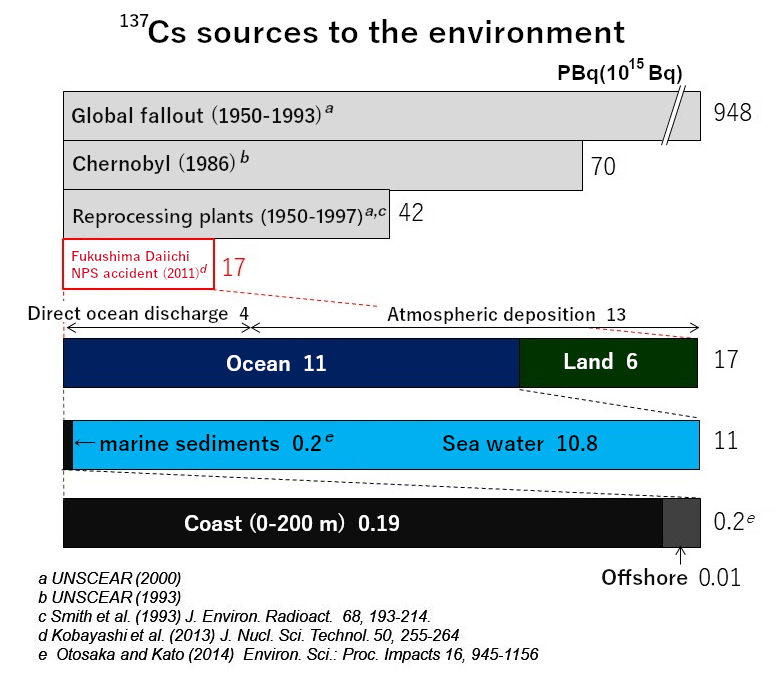Radioactivity and Air Dose Rate
(2014)
QWhat kinds of radioactive materials were released into the atmosphere and the sea and how much?
AVarious kinds of radioactive material were released in large amounts by the accident. Many of them have short half-lives or are small in the amount released. Cs-137 (137Cs) is a key radioactive material that still remains.
Table 1 Major radioactive materials released by the Fukushima accident and their half-lives
| Radioactive material | Half Life |
|---|---|
| Xenon-133(133Xe) | 5.2 day |
| Cesium-134(134Cs) | 2.1 year |
| Cesium-137(137Cs) | 30 year |
| Strontium-89(89Sr) | 50.5 day |
| Strontium-90(90Sr) | 29.1 year |
| Tellurium-129m(129mTe) | 33.6 day |
| Plutonium-238(238Pu) | 87.7 year |
| Plutonium-239(239Pu) | 24,065 year |
| Plutonium-240(240Pu) | 6,537 year |
| Plutonium-241(241Pu) | 14.4 year |
| Iodine-131(131I) | 8 day |
Table 2 Estimated released amount of 137Cs compiled by UNSCEAR* (PBq)
| Amount of 137Cs present in Units 1 to 3 at the time of the accident |
Released into the atmosphere | Released into the sea | |
|---|---|---|---|
| Direct discharge | Indirect discharge | ||
| 700 | 6-20 | 3-6 | 5-8 |
- The estimated amount of 131I released into the atmosphere is 100-500 PBq and that of 137Cs is 6-20 PBq (for 134Cs, the estimated amount is similar to that of 137Cs).
- The release started in massive amounts on March 12, 2011, with violent fluctuations continuing for a week, and gradually reduced. By early April, the amount was reduced below 1/1000 of the first week.
- Since no measurements are available on the released amounts, several institutions predicted them by using various data and methods.
- UNSCEAR recommends JAEA’s estimates as adequate to be used as rational basic data for predicting the time and space distribution of radionuclides in the terrestrial environment.
- Based on its released amount and half-life, 137Cs is considered a key radioactive material that will require attention for years to come.
- JAEA’s research shows that the estimated amount of 137Cs released by the accident at the Fukushima Daiichi Nuclear Power Station is approximately 17 PBq. About 13 PBq of this total was released into the atmosphere, and about 4 PBq was directly released into the sea.
- The estimated amount of 137Cs that was released into the atmosphere and then deposited on land is about 6 PBq.
- A total of 11 PBq of 137Cs was released into the sea, including the amount of direct release and the amount first released into the atmosphere and then deposited in the sea. An estimated 0.2 PBq of this amount adhered to the seabed soil, and the rest is assumed to have diffused and diluted into the ocean.
- Studies are revealing that the amount of cesium that is deposited on land and then discharged through rivers is very limited.

Fig.1 Environmental release of Cs-137 (PBq)
Related articles
References
- UNSCEAR(2014): UNSCEAR: Sources, Effects and Risks of Ionizing Radiation, UNSCEAR 2013 Report to the General Assembly with Scientific Annexes volume I Scientific Annex A, United Nations, New York.
- Kobayashi, T., Nagai, H., Chino, M. and Kawamura, H. (2013): Source term estimation of atmospheric release due to the Fukushima Dai-ichi Nuclear Power Plant accident by atmospheric and oceanic dispersion simulations, Journal of Nuclear Science and Technology, vol. 50, no. 3, 255–264. http://dx.doi.org/10.1080/00223131.2013.772449
- Otosaka, S. and Kato, Y. (2014): Radiocesium derived from the Fukushima Daiichi Nuclear Power Plant accident in seabed sediments; Initial deposition and inventories, Environmental Science; Processes & Impacts, vol. 16, no. 5, 978-990. https://doi.org/10.1039/c4em00016a
